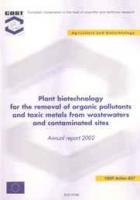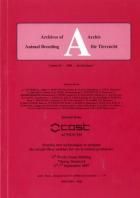
Weather Radar Networking - Status Reports

Plant Biotechnology for the Removal of Organic Pollutants and toxic Metals from Wastewaters and Contaminated Sites - Annual Report 2002

Atlas Historique des Cadastres d'Europe

PRO Ligno, Number 3, 2007

Forschubng für den Markt Geschichte der Fraunhofer-Gesellschaft

Archives of Animal Breeding - Possible New Technologies to Esti-mate the Muscle Fiber for Use in Animal Production
- Pages: 90
- Author(s): E. Von Borell, G. Brockmann, R. Claus, O. Distl et al.
- Publisher(s): Druck & Werbew-erkstatt
European meat and fish producers are continuously challenges for efficiency of production, animal welfare and meat/fish quality. In meat/fish production muscle growth is the most important trait of the production economy and the muscle growth rate may influence the quality of the meat produced. Muscle fibres are formed during foetal development, and number and hypertopic growth determines the growth rate of the animal to a large extent. The number of muscle fibre formed during foetal development is directly related to postnatal muscle growth.
However, because studies on the number of muscle fibres are tedious and costly it is important that research in this area is complementary instead of duplicating. An initiative was consequently taken to initiate a COST Action entitled 3The Importance of prenatal Events for Postnatal Muscle Growth in Relation to the Quality of Muscle Based Foods”.
This Special Issue of Archives of Animal Breeding contains the contributions of the participants to the sessions of the two working groups presented as one invited paper, 16 oral contributions and 20 posters that report on current scientific activities and results. Furthermore, a workshop on the relationship between gene expression and muscle fibre number was held followed by a plenary discussion.

International Workshop on Earthquake Engineering on Timber Structures
- Pages: 200
- Author(s): Dr. V. Enjily
- Publisher(s): University of Coimbra
Proceedings of the International Workshop on “Earthquake Engineering on Timber Structures”, which took place in Coimbra, Portugal on 9-10 November 2006.

Annals of Silvicultural Research - Special Issue: COST Action FP1202: “Marginal and peripheral tree populations: a key genetic resource for European forests”
- Author(s): Ducci, F., Cutino, I. (Eds.)
- Publisher(s): Crea Journals
- https://journals-crea.4science.it/index.php/asr/issue/view/210
This Special Issue outlines the results of COST Action FP1202 “Marginal and peripheral tree populations: a key genetic resource for European forests”.

Audience Research Methodologies: Between Innovation and Consolidation
- Author(s): Edited by Geoffroy Patriarche, Helena Bilandzic, Jakob Linaa Jensen, Jelena Jurišic
- Publisher(s): Routledge
- http://www.routledge.com/books/details/9780415827355/
The transformations of people’s relations to media content, technologies and institutions raise new methodological challenges and opportunities for audience research. This edited volume aims at contributing to the development of the repertoire of methods and methodologies for audience research by reviewing and exemplifying approaches that have been stimulated by the changing conditions and practices of audiences. The contributions address a range of issues and approaches related to the diversification, integration and triangulation of methods for audience research, to the gap between the researched and the researchers, to the study of online social networks, and to the opportunities brought about by Web 2.0 technologies as research tools.
